Detailed Financial Analysis and Investment Appraisal of IHG Group
VerifiedAdded on 2023/01/11
|14
|3925
|37
Report
AI Summary
This report provides a comprehensive financial analysis of InterContinental Hotels Group (IHG), examining its performance over the past five years. It evaluates the company's profitability, liquidity, and key financial ratios, highlighting trends and potential risks. The report delves into future investment appraisals, utilizing Net Present Value (NPV) and Internal Rate of Return (IRR) techniques to assess the viability of a proposed investment. Furthermore, it explores the potential acquisition of the Six Senses Hotel Group, analyzing the rationale behind the acquisition, potential synergistic gains, financing options, associated risks, and the impact on IHG's performance. The report concludes with recommendations based on the financial analysis and investment appraisal findings, offering insights into IHG's strategic direction and financial health.

FINANCE FOR
DECISION MAKING
DECISION MAKING
Paraphrase This Document
Need a fresh take? Get an instant paraphrase of this document with our AI Paraphraser
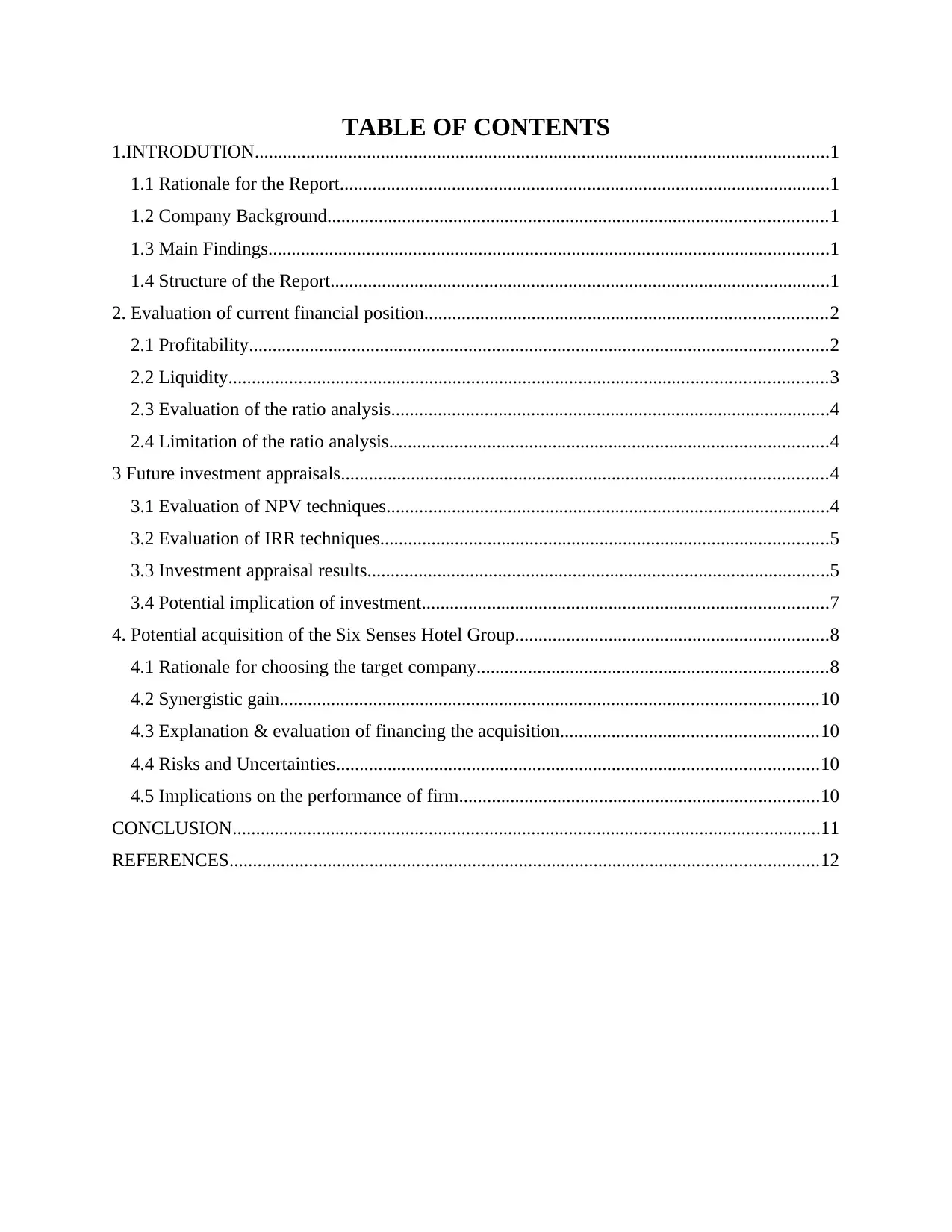
TABLE OF CONTENTS
1.INTRODUTION...........................................................................................................................1
1.1 Rationale for the Report.........................................................................................................1
1.2 Company Background...........................................................................................................1
1.3 Main Findings........................................................................................................................1
1.4 Structure of the Report...........................................................................................................1
2. Evaluation of current financial position......................................................................................2
2.1 Profitability............................................................................................................................2
2.2 Liquidity................................................................................................................................3
2.3 Evaluation of the ratio analysis..............................................................................................4
2.4 Limitation of the ratio analysis..............................................................................................4
3 Future investment appraisals........................................................................................................4
3.1 Evaluation of NPV techniques...............................................................................................4
3.2 Evaluation of IRR techniques................................................................................................5
3.3 Investment appraisal results...................................................................................................5
3.4 Potential implication of investment.......................................................................................7
4. Potential acquisition of the Six Senses Hotel Group...................................................................8
4.1 Rationale for choosing the target company...........................................................................8
4.2 Synergistic gain...................................................................................................................10
4.3 Explanation & evaluation of financing the acquisition.......................................................10
4.4 Risks and Uncertainties.......................................................................................................10
4.5 Implications on the performance of firm.............................................................................10
CONCLUSION..............................................................................................................................11
REFERENCES..............................................................................................................................12
1.INTRODUTION...........................................................................................................................1
1.1 Rationale for the Report.........................................................................................................1
1.2 Company Background...........................................................................................................1
1.3 Main Findings........................................................................................................................1
1.4 Structure of the Report...........................................................................................................1
2. Evaluation of current financial position......................................................................................2
2.1 Profitability............................................................................................................................2
2.2 Liquidity................................................................................................................................3
2.3 Evaluation of the ratio analysis..............................................................................................4
2.4 Limitation of the ratio analysis..............................................................................................4
3 Future investment appraisals........................................................................................................4
3.1 Evaluation of NPV techniques...............................................................................................4
3.2 Evaluation of IRR techniques................................................................................................5
3.3 Investment appraisal results...................................................................................................5
3.4 Potential implication of investment.......................................................................................7
4. Potential acquisition of the Six Senses Hotel Group...................................................................8
4.1 Rationale for choosing the target company...........................................................................8
4.2 Synergistic gain...................................................................................................................10
4.3 Explanation & evaluation of financing the acquisition.......................................................10
4.4 Risks and Uncertainties.......................................................................................................10
4.5 Implications on the performance of firm.............................................................................10
CONCLUSION..............................................................................................................................11
REFERENCES..............................................................................................................................12

1.INTRODUTION
1.1 Rationale for the Report
InterContinental Group has successfully achieved the financial success over the past 5
years. The performance of the company is showing adequate returns over the capital which
shows that the company is achieving growth and success. IHG group is achieving adequate
returns from the last year company for expanding its business is planning to make new
investments and acquisitions. Study will summarise the financial position of IHG over the
current scenario.
1.2 Company Background
IHG is an international British hospitality company which is headquartered in
Buckinghamshire, England. Company has a hotel group of around 5656 hotels in around 100
countries. Company was founded in the year 2003 and it has been 17 years since the company is
operating. It has hotels and resorts. Company has made many acquisitions since its incorporation.
Company is successfully operating with the annual revenues of 4.627 billion and operating
income of 630 million. It is giving adequate returns to the shareholders and is earning net income
386 million. Company is planning to expand its business by acquiring new hotels for entering
into new markets. However since 2015 there has been a decline in the level of profits of
company. As per the current scenario performance of company is adequate and financial position
is strong.
1.3 Main Findings
From the research it has been found that the IHG is having robust health at the same time is
achieving growth every year as analysed from the last 5 year. The motive of expansions is
achieved by effective investment strategies over the years. The acquisition of big group affects
the profitability in initial year however it returns back to profitable stage by implementing
strategies expanding its business to new markets. The market share of the company has increased
significantly in the last 10 years. Company is having strong potential of acquiring the new hotel
group by adequately managing the exposure to risks associated with it.
1.4 Structure of the Report
Section 2 will provide the analysis of current standing of the Intercontinental Hotels Group.
Section 3 will provide evaluation using IRR and NPV for the investments in current company.
1
1.1 Rationale for the Report
InterContinental Group has successfully achieved the financial success over the past 5
years. The performance of the company is showing adequate returns over the capital which
shows that the company is achieving growth and success. IHG group is achieving adequate
returns from the last year company for expanding its business is planning to make new
investments and acquisitions. Study will summarise the financial position of IHG over the
current scenario.
1.2 Company Background
IHG is an international British hospitality company which is headquartered in
Buckinghamshire, England. Company has a hotel group of around 5656 hotels in around 100
countries. Company was founded in the year 2003 and it has been 17 years since the company is
operating. It has hotels and resorts. Company has made many acquisitions since its incorporation.
Company is successfully operating with the annual revenues of 4.627 billion and operating
income of 630 million. It is giving adequate returns to the shareholders and is earning net income
386 million. Company is planning to expand its business by acquiring new hotels for entering
into new markets. However since 2015 there has been a decline in the level of profits of
company. As per the current scenario performance of company is adequate and financial position
is strong.
1.3 Main Findings
From the research it has been found that the IHG is having robust health at the same time is
achieving growth every year as analysed from the last 5 year. The motive of expansions is
achieved by effective investment strategies over the years. The acquisition of big group affects
the profitability in initial year however it returns back to profitable stage by implementing
strategies expanding its business to new markets. The market share of the company has increased
significantly in the last 10 years. Company is having strong potential of acquiring the new hotel
group by adequately managing the exposure to risks associated with it.
1.4 Structure of the Report
Section 2 will provide the analysis of current standing of the Intercontinental Hotels Group.
Section 3 will provide evaluation using IRR and NPV for the investments in current company.
1
⊘ This is a preview!⊘
Do you want full access?
Subscribe today to unlock all pages.

Trusted by 1+ million students worldwide
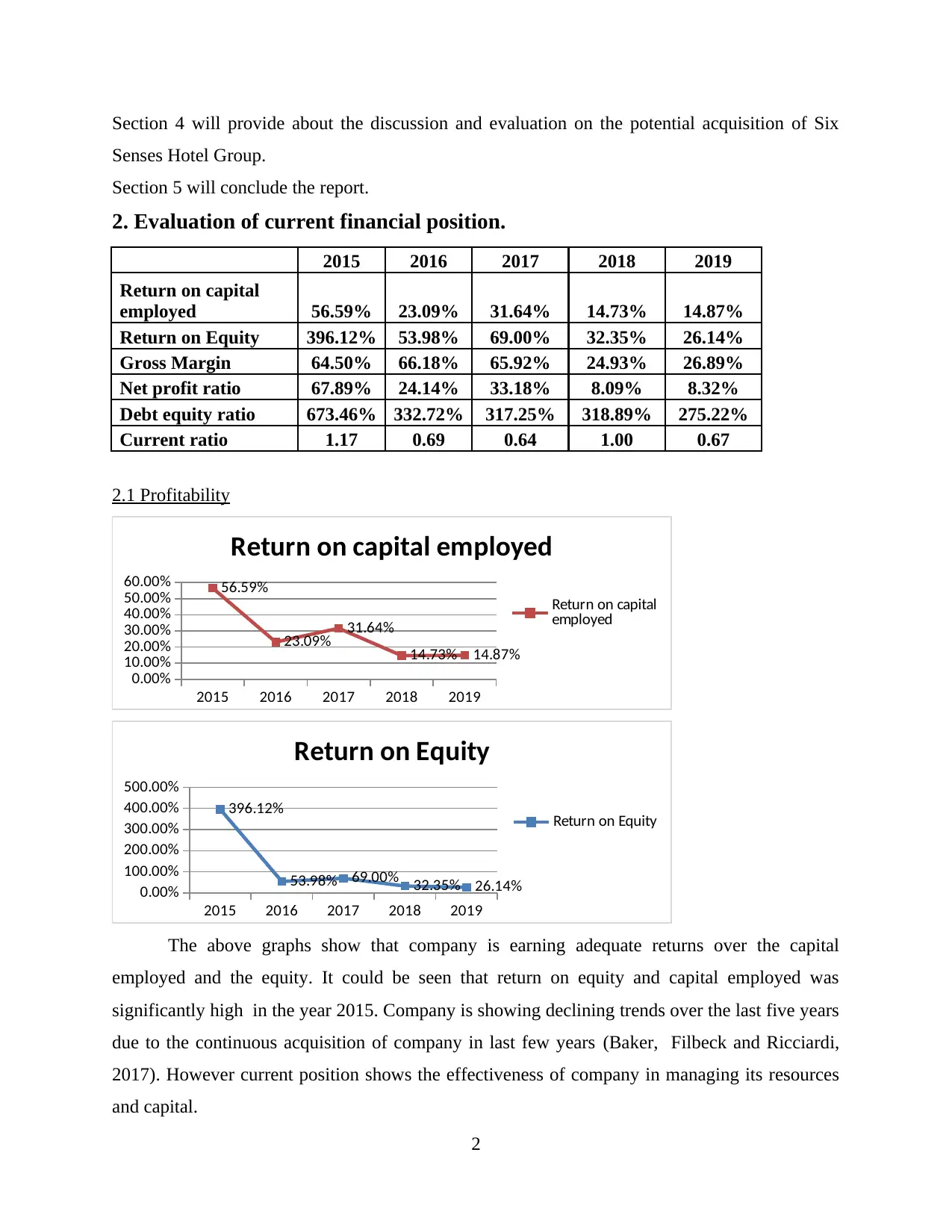
Section 4 will provide about the discussion and evaluation on the potential acquisition of Six
Senses Hotel Group.
Section 5 will conclude the report.
2. Evaluation of current financial position.
2015 2016 2017 2018 2019
Return on capital
employed 56.59% 23.09% 31.64% 14.73% 14.87%
Return on Equity 396.12% 53.98% 69.00% 32.35% 26.14%
Gross Margin 64.50% 66.18% 65.92% 24.93% 26.89%
Net profit ratio 67.89% 24.14% 33.18% 8.09% 8.32%
Debt equity ratio 673.46% 332.72% 317.25% 318.89% 275.22%
Current ratio 1.17 0.69 0.64 1.00 0.67
2.1 Profitability
2015 2016 2017 2018 2019
0.00%
10.00%
20.00%
30.00%
40.00%
50.00%
60.00% 56.59%
23.09% 31.64%
14.73% 14.87%
Return on capital employed
Return on capital
employed
2015 2016 2017 2018 2019
0.00%
100.00%
200.00%
300.00%
400.00%
500.00%
396.12%
53.98% 69.00% 32.35% 26.14%
Return on Equity
Return on Equity
The above graphs show that company is earning adequate returns over the capital
employed and the equity. It could be seen that return on equity and capital employed was
significantly high in the year 2015. Company is showing declining trends over the last five years
due to the continuous acquisition of company in last few years (Baker, Filbeck and Ricciardi,
2017). However current position shows the effectiveness of company in managing its resources
and capital.
2
Senses Hotel Group.
Section 5 will conclude the report.
2. Evaluation of current financial position.
2015 2016 2017 2018 2019
Return on capital
employed 56.59% 23.09% 31.64% 14.73% 14.87%
Return on Equity 396.12% 53.98% 69.00% 32.35% 26.14%
Gross Margin 64.50% 66.18% 65.92% 24.93% 26.89%
Net profit ratio 67.89% 24.14% 33.18% 8.09% 8.32%
Debt equity ratio 673.46% 332.72% 317.25% 318.89% 275.22%
Current ratio 1.17 0.69 0.64 1.00 0.67
2.1 Profitability
2015 2016 2017 2018 2019
0.00%
10.00%
20.00%
30.00%
40.00%
50.00%
60.00% 56.59%
23.09% 31.64%
14.73% 14.87%
Return on capital employed
Return on capital
employed
2015 2016 2017 2018 2019
0.00%
100.00%
200.00%
300.00%
400.00%
500.00%
396.12%
53.98% 69.00% 32.35% 26.14%
Return on Equity
Return on Equity
The above graphs show that company is earning adequate returns over the capital
employed and the equity. It could be seen that return on equity and capital employed was
significantly high in the year 2015. Company is showing declining trends over the last five years
due to the continuous acquisition of company in last few years (Baker, Filbeck and Ricciardi,
2017). However current position shows the effectiveness of company in managing its resources
and capital.
2
Paraphrase This Document
Need a fresh take? Get an instant paraphrase of this document with our AI Paraphraser
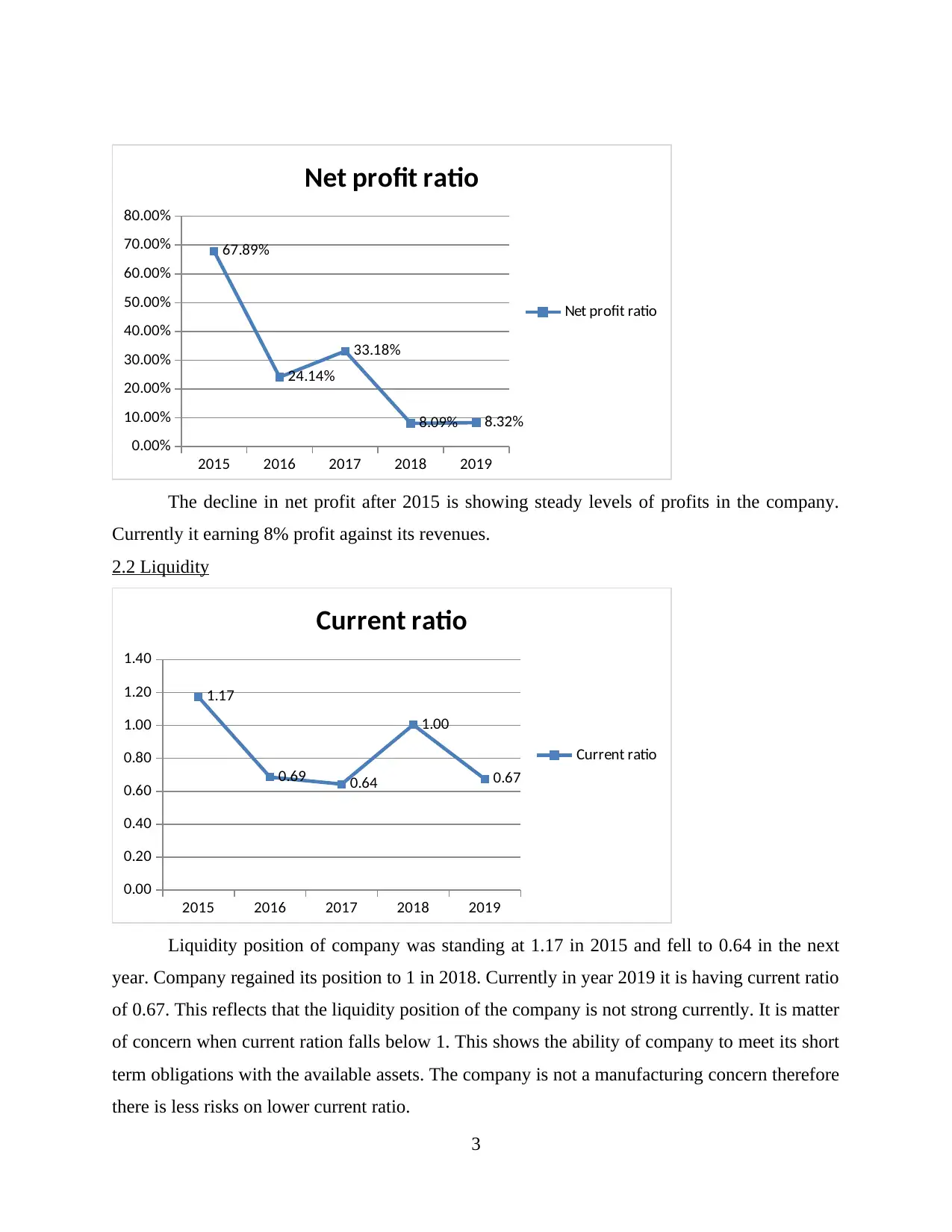
2015 2016 2017 2018 2019
0.00%
10.00%
20.00%
30.00%
40.00%
50.00%
60.00%
70.00%
80.00%
67.89%
24.14%
33.18%
8.09% 8.32%
Net profit ratio
Net profit ratio
The decline in net profit after 2015 is showing steady levels of profits in the company.
Currently it earning 8% profit against its revenues.
2.2 Liquidity
2015 2016 2017 2018 2019
0.00
0.20
0.40
0.60
0.80
1.00
1.20
1.40
1.17
0.69 0.64
1.00
0.67
Current ratio
Current ratio
Liquidity position of company was standing at 1.17 in 2015 and fell to 0.64 in the next
year. Company regained its position to 1 in 2018. Currently in year 2019 it is having current ratio
of 0.67. This reflects that the liquidity position of the company is not strong currently. It is matter
of concern when current ration falls below 1. This shows the ability of company to meet its short
term obligations with the available assets. The company is not a manufacturing concern therefore
there is less risks on lower current ratio.
3
0.00%
10.00%
20.00%
30.00%
40.00%
50.00%
60.00%
70.00%
80.00%
67.89%
24.14%
33.18%
8.09% 8.32%
Net profit ratio
Net profit ratio
The decline in net profit after 2015 is showing steady levels of profits in the company.
Currently it earning 8% profit against its revenues.
2.2 Liquidity
2015 2016 2017 2018 2019
0.00
0.20
0.40
0.60
0.80
1.00
1.20
1.40
1.17
0.69 0.64
1.00
0.67
Current ratio
Current ratio
Liquidity position of company was standing at 1.17 in 2015 and fell to 0.64 in the next
year. Company regained its position to 1 in 2018. Currently in year 2019 it is having current ratio
of 0.67. This reflects that the liquidity position of the company is not strong currently. It is matter
of concern when current ration falls below 1. This shows the ability of company to meet its short
term obligations with the available assets. The company is not a manufacturing concern therefore
there is less risks on lower current ratio.
3

2.3 Evaluation of the ratio analysis
From the above ratios it is analysed that the profitability of the company is declined over
the last five years. However managed the net profit margins at8% over the last two years. It will
be further increased by implementing new effective corporate strategies. Liquidity position of the
company has to be strengthened as this could attract new risks to company. Return over capital
employed and equity are adequate which will help in gaining the confidence of investors in the
company (Shahid, Aftab, Latif and Mahmood, 2018). Acquisition of Six Senses in cash will
require further cash funds to be raised by the business.
2.4 Limitation of the ratio analysis
The ratios used in the analysis do not reveal the actual position of company. the internal
management of the company could not be judged using the ratios. They only give quantitative
information and qualitative aspects are often ignored in the ratio analysis. Though the movement
could be measured but it does not gives the solution for improvement.
3 Future investment appraisals
There are three most important investment appraisal techniques which is mostly used by
all the business entities, which are, payback period (PBP), net present value (NPV) and internal
rate of return (IRR). These techniques are used to appraise the profitability of eth new project
(Bonazzi and Iotti, 2016). Each and every project is evaluated from varied angles and provides
different insights about each of these. Net present value and internal rate of return are the part of
discounted cash flow. These methods are used for comparing and evaluating the alternative
investment opportunities available which will help in ensuring better long-term financial return
for the business entity.
3.1 Evaluation of NPV techniques
The net present value is the most common method of investment appraisal. It is derived
by deducting present value of cash outflow from the present value of cash inflow. It uses
discounting factor for deriving the future cash flows in the present value (Sinha and Datta, 2020).
This technique is considered to the most appropriate method than other methods such as payback
period method or Internal rate of return because this technique takes into account the time value
of money. Unlike IRR, NPV makes sense as it does not assume that the cash flows will be
reinvested at the rate of return. This method is not affected the conventional cash flows such
positive and negative in between the life of the project. It also takes into consideration each and
4
From the above ratios it is analysed that the profitability of the company is declined over
the last five years. However managed the net profit margins at8% over the last two years. It will
be further increased by implementing new effective corporate strategies. Liquidity position of the
company has to be strengthened as this could attract new risks to company. Return over capital
employed and equity are adequate which will help in gaining the confidence of investors in the
company (Shahid, Aftab, Latif and Mahmood, 2018). Acquisition of Six Senses in cash will
require further cash funds to be raised by the business.
2.4 Limitation of the ratio analysis
The ratios used in the analysis do not reveal the actual position of company. the internal
management of the company could not be judged using the ratios. They only give quantitative
information and qualitative aspects are often ignored in the ratio analysis. Though the movement
could be measured but it does not gives the solution for improvement.
3 Future investment appraisals
There are three most important investment appraisal techniques which is mostly used by
all the business entities, which are, payback period (PBP), net present value (NPV) and internal
rate of return (IRR). These techniques are used to appraise the profitability of eth new project
(Bonazzi and Iotti, 2016). Each and every project is evaluated from varied angles and provides
different insights about each of these. Net present value and internal rate of return are the part of
discounted cash flow. These methods are used for comparing and evaluating the alternative
investment opportunities available which will help in ensuring better long-term financial return
for the business entity.
3.1 Evaluation of NPV techniques
The net present value is the most common method of investment appraisal. It is derived
by deducting present value of cash outflow from the present value of cash inflow. It uses
discounting factor for deriving the future cash flows in the present value (Sinha and Datta, 2020).
This technique is considered to the most appropriate method than other methods such as payback
period method or Internal rate of return because this technique takes into account the time value
of money. Unlike IRR, NPV makes sense as it does not assume that the cash flows will be
reinvested at the rate of return. This method is not affected the conventional cash flows such
positive and negative in between the life of the project. It also takes into consideration each and
4
⊘ This is a preview!⊘
Do you want full access?
Subscribe today to unlock all pages.

Trusted by 1+ million students worldwide

every cash flow unlike payback period where cash flow beyond the cash flow is ignored. But this
method is not suitable for projects of different sizes.
3.2 Evaluation of IRR techniques
It is the discounting rate which brings the discounted future cash flows at the par value
with the initial cash outflow. In simple terms, it is the rate at which NPV is zero. It is mainly
obtained by using trial and error approach (Patrick and French, 2016). It is used for analysing the
profitability but it can eb misleading when it is used alone for analysing the project as the project
may have low IRR but higher NPV. In case of long project, initially it may bring less income but
will add value over time. Another drawback of this technique is that a project may have low IRR
and Low NPV but then too it is feasible to consider this project because of other reasons like risk
diversification, may bring opportunities in the future or it may add value to the business.
3.3 Investment appraisal results
Under this section, the company is willing to invest in the new project in respect to
further investing in its existing product of £45m with the expected life of the project to be 10
years and the discounting rate is 12%, ignoring inflation and tax. It is assumed that the cash
inflow is 30% of initial investment for next 10 years.
Computation of NPV at £45m investment
Year
Cash inflows
in £
PV factor
@ 12%
Discounted
cash
inflows in
£
1 13500000 0.893 12053571
2 13500000 0.797 10762117
3 13500000 0.712 9609033
4 13500000 0.636 8579494
5 13500000 0.567 7660263
6 13500000 0.507 6839520
7 13500000 0.452 6106714
8 13500000 0.404 5452424
5
method is not suitable for projects of different sizes.
3.2 Evaluation of IRR techniques
It is the discounting rate which brings the discounted future cash flows at the par value
with the initial cash outflow. In simple terms, it is the rate at which NPV is zero. It is mainly
obtained by using trial and error approach (Patrick and French, 2016). It is used for analysing the
profitability but it can eb misleading when it is used alone for analysing the project as the project
may have low IRR but higher NPV. In case of long project, initially it may bring less income but
will add value over time. Another drawback of this technique is that a project may have low IRR
and Low NPV but then too it is feasible to consider this project because of other reasons like risk
diversification, may bring opportunities in the future or it may add value to the business.
3.3 Investment appraisal results
Under this section, the company is willing to invest in the new project in respect to
further investing in its existing product of £45m with the expected life of the project to be 10
years and the discounting rate is 12%, ignoring inflation and tax. It is assumed that the cash
inflow is 30% of initial investment for next 10 years.
Computation of NPV at £45m investment
Year
Cash inflows
in £
PV factor
@ 12%
Discounted
cash
inflows in
£
1 13500000 0.893 12053571
2 13500000 0.797 10762117
3 13500000 0.712 9609033
4 13500000 0.636 8579494
5 13500000 0.567 7660263
6 13500000 0.507 6839520
7 13500000 0.452 6106714
8 13500000 0.404 5452424
5
Paraphrase This Document
Need a fresh take? Get an instant paraphrase of this document with our AI Paraphraser
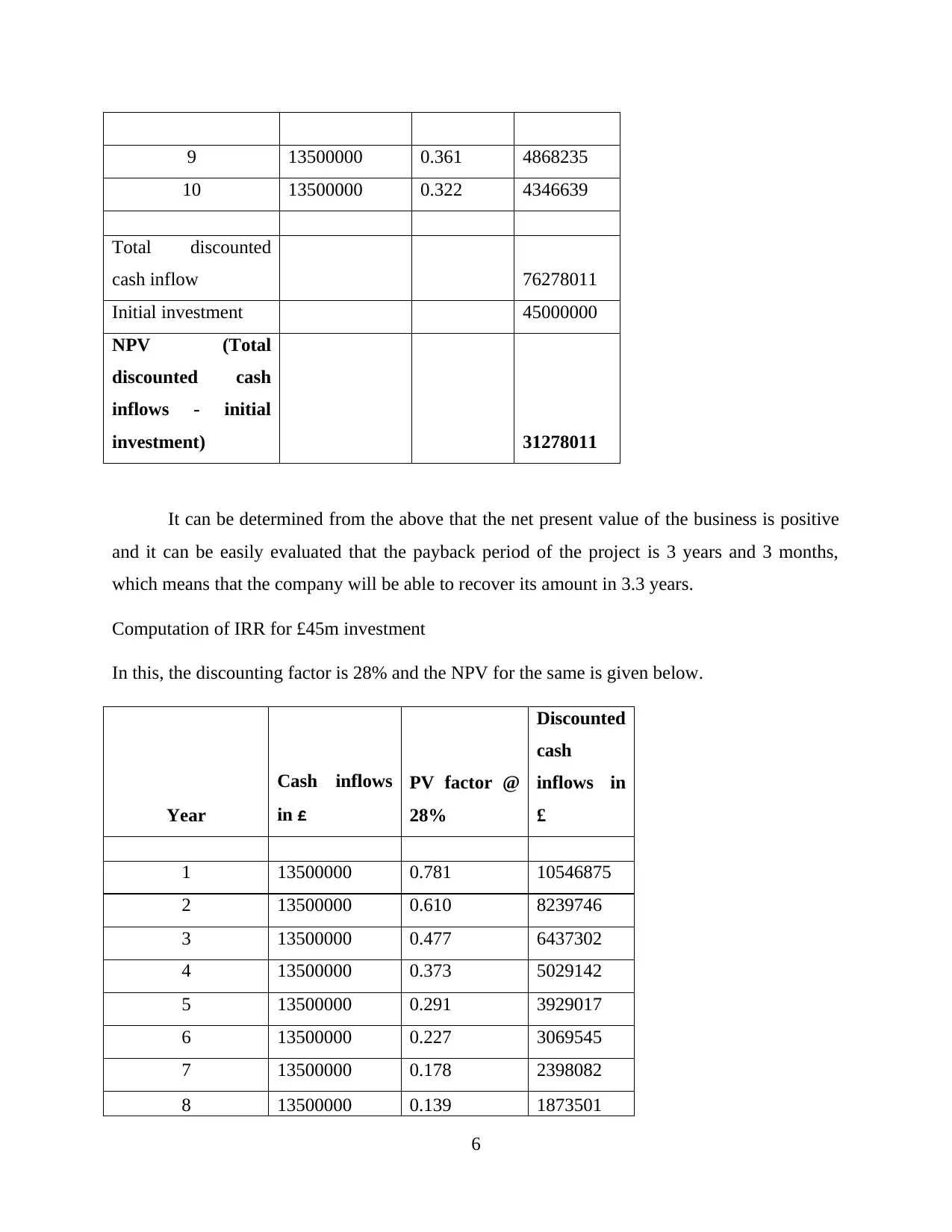
9 13500000 0.361 4868235
10 13500000 0.322 4346639
Total discounted
cash inflow 76278011
Initial investment 45000000
NPV (Total
discounted cash
inflows - initial
investment) 31278011
It can be determined from the above that the net present value of the business is positive
and it can be easily evaluated that the payback period of the project is 3 years and 3 months,
which means that the company will be able to recover its amount in 3.3 years.
Computation of IRR for £45m investment
In this, the discounting factor is 28% and the NPV for the same is given below.
Year
Cash inflows
in £
PV factor @
28%
Discounted
cash
inflows in
£
1 13500000 0.781 10546875
2 13500000 0.610 8239746
3 13500000 0.477 6437302
4 13500000 0.373 5029142
5 13500000 0.291 3929017
6 13500000 0.227 3069545
7 13500000 0.178 2398082
8 13500000 0.139 1873501
6
10 13500000 0.322 4346639
Total discounted
cash inflow 76278011
Initial investment 45000000
NPV (Total
discounted cash
inflows - initial
investment) 31278011
It can be determined from the above that the net present value of the business is positive
and it can be easily evaluated that the payback period of the project is 3 years and 3 months,
which means that the company will be able to recover its amount in 3.3 years.
Computation of IRR for £45m investment
In this, the discounting factor is 28% and the NPV for the same is given below.
Year
Cash inflows
in £
PV factor @
28%
Discounted
cash
inflows in
£
1 13500000 0.781 10546875
2 13500000 0.610 8239746
3 13500000 0.477 6437302
4 13500000 0.373 5029142
5 13500000 0.291 3929017
6 13500000 0.227 3069545
7 13500000 0.178 2398082
8 13500000 0.139 1873501
6
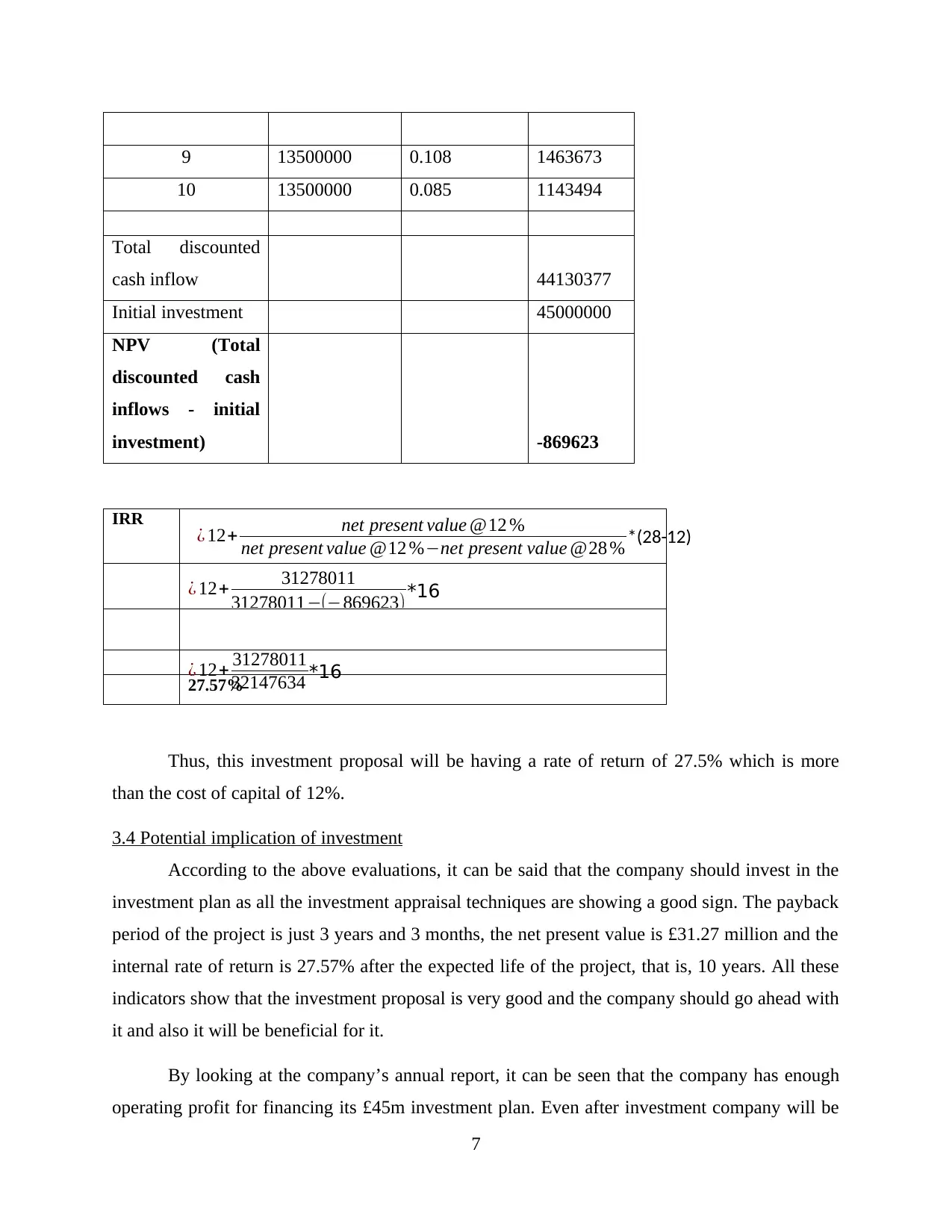
9 13500000 0.108 1463673
10 13500000 0.085 1143494
Total discounted
cash inflow 44130377
Initial investment 45000000
NPV (Total
discounted cash
inflows - initial
investment) -869623
IRR
27.57%
Thus, this investment proposal will be having a rate of return of 27.5% which is more
than the cost of capital of 12%.
3.4 Potential implication of investment
According to the above evaluations, it can be said that the company should invest in the
investment plan as all the investment appraisal techniques are showing a good sign. The payback
period of the project is just 3 years and 3 months, the net present value is £31.27 million and the
internal rate of return is 27.57% after the expected life of the project, that is, 10 years. All these
indicators show that the investment proposal is very good and the company should go ahead with
it and also it will be beneficial for it.
By looking at the company’s annual report, it can be seen that the company has enough
operating profit for financing its £45m investment plan. Even after investment company will be
7
¿ 12+ net present value @12 %
net present value @12 %−net present value @28 % *(28-12)
¿ 12+ 31278011
31278011−(−869623)*16
¿ 12+ 31278011
32147634 *16
10 13500000 0.085 1143494
Total discounted
cash inflow 44130377
Initial investment 45000000
NPV (Total
discounted cash
inflows - initial
investment) -869623
IRR
27.57%
Thus, this investment proposal will be having a rate of return of 27.5% which is more
than the cost of capital of 12%.
3.4 Potential implication of investment
According to the above evaluations, it can be said that the company should invest in the
investment plan as all the investment appraisal techniques are showing a good sign. The payback
period of the project is just 3 years and 3 months, the net present value is £31.27 million and the
internal rate of return is 27.57% after the expected life of the project, that is, 10 years. All these
indicators show that the investment proposal is very good and the company should go ahead with
it and also it will be beneficial for it.
By looking at the company’s annual report, it can be seen that the company has enough
operating profit for financing its £45m investment plan. Even after investment company will be
7
¿ 12+ net present value @12 %
net present value @12 %−net present value @28 % *(28-12)
¿ 12+ 31278011
31278011−(−869623)*16
¿ 12+ 31278011
32147634 *16
⊘ This is a preview!⊘
Do you want full access?
Subscribe today to unlock all pages.

Trusted by 1+ million students worldwide

left with sufficient amount to carry its other expenses efficiently. Thus, Intercontinental Hotel
Group Plc should invest in the plan.
4. Potential acquisition of the Six Senses Hotel Group
Six Senses is currently managing around 16 resorts and hotels with eighteen management
contracts signed in pipeline and 50 more deals with the active discussion. Properties of the
Hotels are located in Seychelles, Maldives, Thailand, Douro Valley in Portugal, Bay in Oman.
Company also have award winning state & high quality pipeline development. Chief executive
officer Neil Jacobs has proposed the deal profitable for both the companies. The proposed
acquisition of brands and operating companies of without including any acquisition of the real
estate assets
4.1 Rationale for choosing the target company
In recent past it has been seen that hospitality industry is changing constantly. Big groups
are continuously expanding by acquisition of boutique hotel groups. There are number of
companies that are acquiring hotels for business expansion (Doumpos and Zopounidis, 2020).
The Six senses is among most adored and respected wellness resort & spa group in world. Six
Senses is having potential acquisition by the IHG group.
The acquisition will be made by the company for cash payments of $300 million from
Pegasus Capital Advisors. Six Senses is holding 16 hotels and is having properties located in
most visited tourists places. The core of the company is Commitment of guest reconnection and
rejuvenation with advanced focus over sustainability and wellness. Acquisition of the company
will extend the reach of IHG over community of the affluent travellers. This will provide entry to
the group in most sought locations of the world. Six Senses will be set at top place of the
portfolio of IHG. Group has previously acquired Regent Hotels & Kimpton Hotels that helped
the company in establishing its presence in fourteen new countries. Acquisition will take the
portfolio of IHG to 400 hotels worldwide.
IHG acquires the companies that are performing well and have gained public trust
through their qualitative services. Six senses is being voted as the top hotel brand of the world
over 2 years that reflects that it is having effective and impressive management team. This will
be adding new experience to the operation of IHG group.
8
Group Plc should invest in the plan.
4. Potential acquisition of the Six Senses Hotel Group
Six Senses is currently managing around 16 resorts and hotels with eighteen management
contracts signed in pipeline and 50 more deals with the active discussion. Properties of the
Hotels are located in Seychelles, Maldives, Thailand, Douro Valley in Portugal, Bay in Oman.
Company also have award winning state & high quality pipeline development. Chief executive
officer Neil Jacobs has proposed the deal profitable for both the companies. The proposed
acquisition of brands and operating companies of without including any acquisition of the real
estate assets
4.1 Rationale for choosing the target company
In recent past it has been seen that hospitality industry is changing constantly. Big groups
are continuously expanding by acquisition of boutique hotel groups. There are number of
companies that are acquiring hotels for business expansion (Doumpos and Zopounidis, 2020).
The Six senses is among most adored and respected wellness resort & spa group in world. Six
Senses is having potential acquisition by the IHG group.
The acquisition will be made by the company for cash payments of $300 million from
Pegasus Capital Advisors. Six Senses is holding 16 hotels and is having properties located in
most visited tourists places. The core of the company is Commitment of guest reconnection and
rejuvenation with advanced focus over sustainability and wellness. Acquisition of the company
will extend the reach of IHG over community of the affluent travellers. This will provide entry to
the group in most sought locations of the world. Six Senses will be set at top place of the
portfolio of IHG. Group has previously acquired Regent Hotels & Kimpton Hotels that helped
the company in establishing its presence in fourteen new countries. Acquisition will take the
portfolio of IHG to 400 hotels worldwide.
IHG acquires the companies that are performing well and have gained public trust
through their qualitative services. Six senses is being voted as the top hotel brand of the world
over 2 years that reflects that it is having effective and impressive management team. This will
be adding new experience to the operation of IHG group.
8
Paraphrase This Document
Need a fresh take? Get an instant paraphrase of this document with our AI Paraphraser
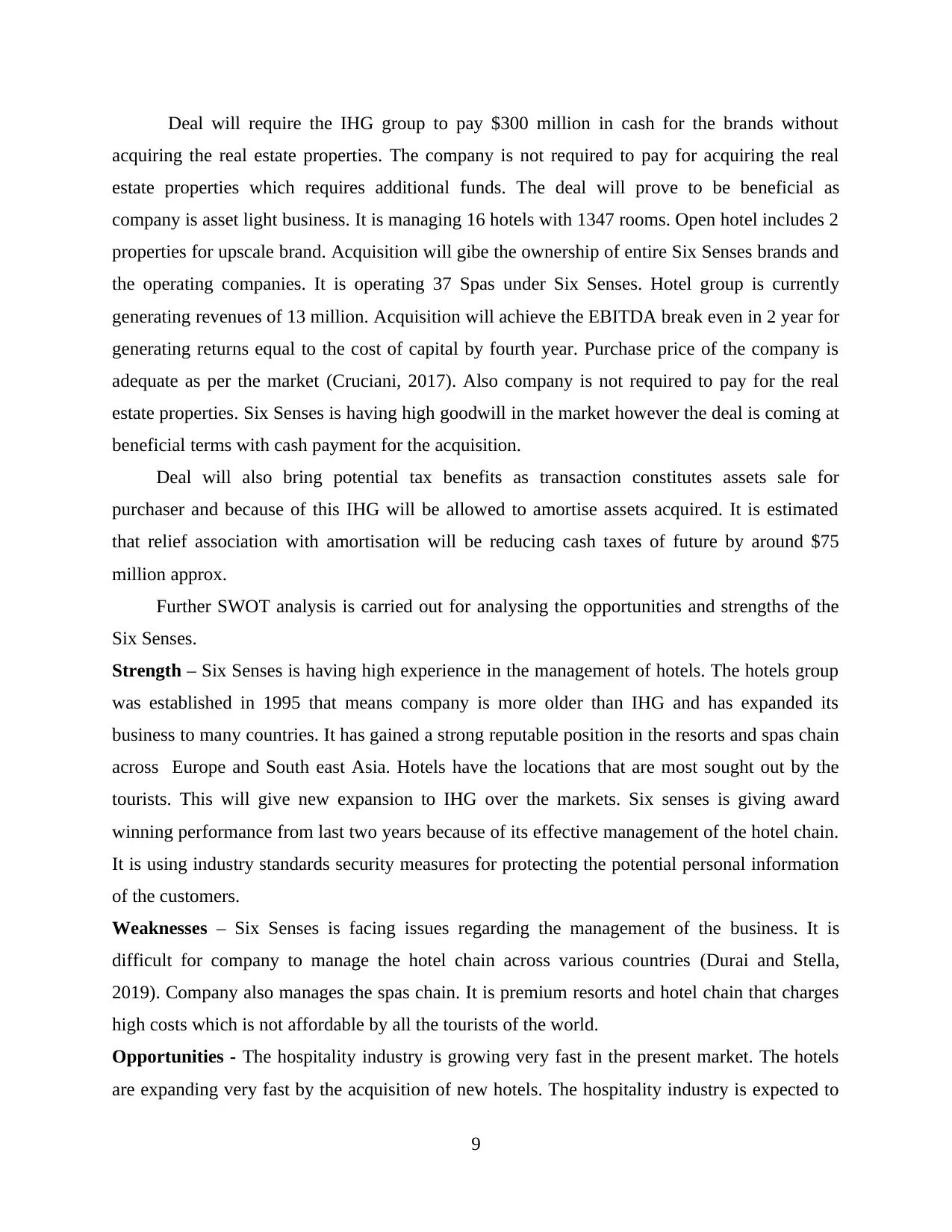
Deal will require the IHG group to pay $300 million in cash for the brands without
acquiring the real estate properties. The company is not required to pay for acquiring the real
estate properties which requires additional funds. The deal will prove to be beneficial as
company is asset light business. It is managing 16 hotels with 1347 rooms. Open hotel includes 2
properties for upscale brand. Acquisition will gibe the ownership of entire Six Senses brands and
the operating companies. It is operating 37 Spas under Six Senses. Hotel group is currently
generating revenues of 13 million. Acquisition will achieve the EBITDA break even in 2 year for
generating returns equal to the cost of capital by fourth year. Purchase price of the company is
adequate as per the market (Cruciani, 2017). Also company is not required to pay for the real
estate properties. Six Senses is having high goodwill in the market however the deal is coming at
beneficial terms with cash payment for the acquisition.
Deal will also bring potential tax benefits as transaction constitutes assets sale for
purchaser and because of this IHG will be allowed to amortise assets acquired. It is estimated
that relief association with amortisation will be reducing cash taxes of future by around $75
million approx.
Further SWOT analysis is carried out for analysing the opportunities and strengths of the
Six Senses.
Strength – Six Senses is having high experience in the management of hotels. The hotels group
was established in 1995 that means company is more older than IHG and has expanded its
business to many countries. It has gained a strong reputable position in the resorts and spas chain
across Europe and South east Asia. Hotels have the locations that are most sought out by the
tourists. This will give new expansion to IHG over the markets. Six senses is giving award
winning performance from last two years because of its effective management of the hotel chain.
It is using industry standards security measures for protecting the potential personal information
of the customers.
Weaknesses – Six Senses is facing issues regarding the management of the business. It is
difficult for company to manage the hotel chain across various countries (Durai and Stella,
2019). Company also manages the spas chain. It is premium resorts and hotel chain that charges
high costs which is not affordable by all the tourists of the world.
Opportunities - The hospitality industry is growing very fast in the present market. The hotels
are expanding very fast by the acquisition of new hotels. The hospitality industry is expected to
9
acquiring the real estate properties. The company is not required to pay for acquiring the real
estate properties which requires additional funds. The deal will prove to be beneficial as
company is asset light business. It is managing 16 hotels with 1347 rooms. Open hotel includes 2
properties for upscale brand. Acquisition will gibe the ownership of entire Six Senses brands and
the operating companies. It is operating 37 Spas under Six Senses. Hotel group is currently
generating revenues of 13 million. Acquisition will achieve the EBITDA break even in 2 year for
generating returns equal to the cost of capital by fourth year. Purchase price of the company is
adequate as per the market (Cruciani, 2017). Also company is not required to pay for the real
estate properties. Six Senses is having high goodwill in the market however the deal is coming at
beneficial terms with cash payment for the acquisition.
Deal will also bring potential tax benefits as transaction constitutes assets sale for
purchaser and because of this IHG will be allowed to amortise assets acquired. It is estimated
that relief association with amortisation will be reducing cash taxes of future by around $75
million approx.
Further SWOT analysis is carried out for analysing the opportunities and strengths of the
Six Senses.
Strength – Six Senses is having high experience in the management of hotels. The hotels group
was established in 1995 that means company is more older than IHG and has expanded its
business to many countries. It has gained a strong reputable position in the resorts and spas chain
across Europe and South east Asia. Hotels have the locations that are most sought out by the
tourists. This will give new expansion to IHG over the markets. Six senses is giving award
winning performance from last two years because of its effective management of the hotel chain.
It is using industry standards security measures for protecting the potential personal information
of the customers.
Weaknesses – Six Senses is facing issues regarding the management of the business. It is
difficult for company to manage the hotel chain across various countries (Durai and Stella,
2019). Company also manages the spas chain. It is premium resorts and hotel chain that charges
high costs which is not affordable by all the tourists of the world.
Opportunities - The hospitality industry is growing very fast in the present market. The hotels
are expanding very fast by the acquisition of new hotels. The hospitality industry is expected to
9
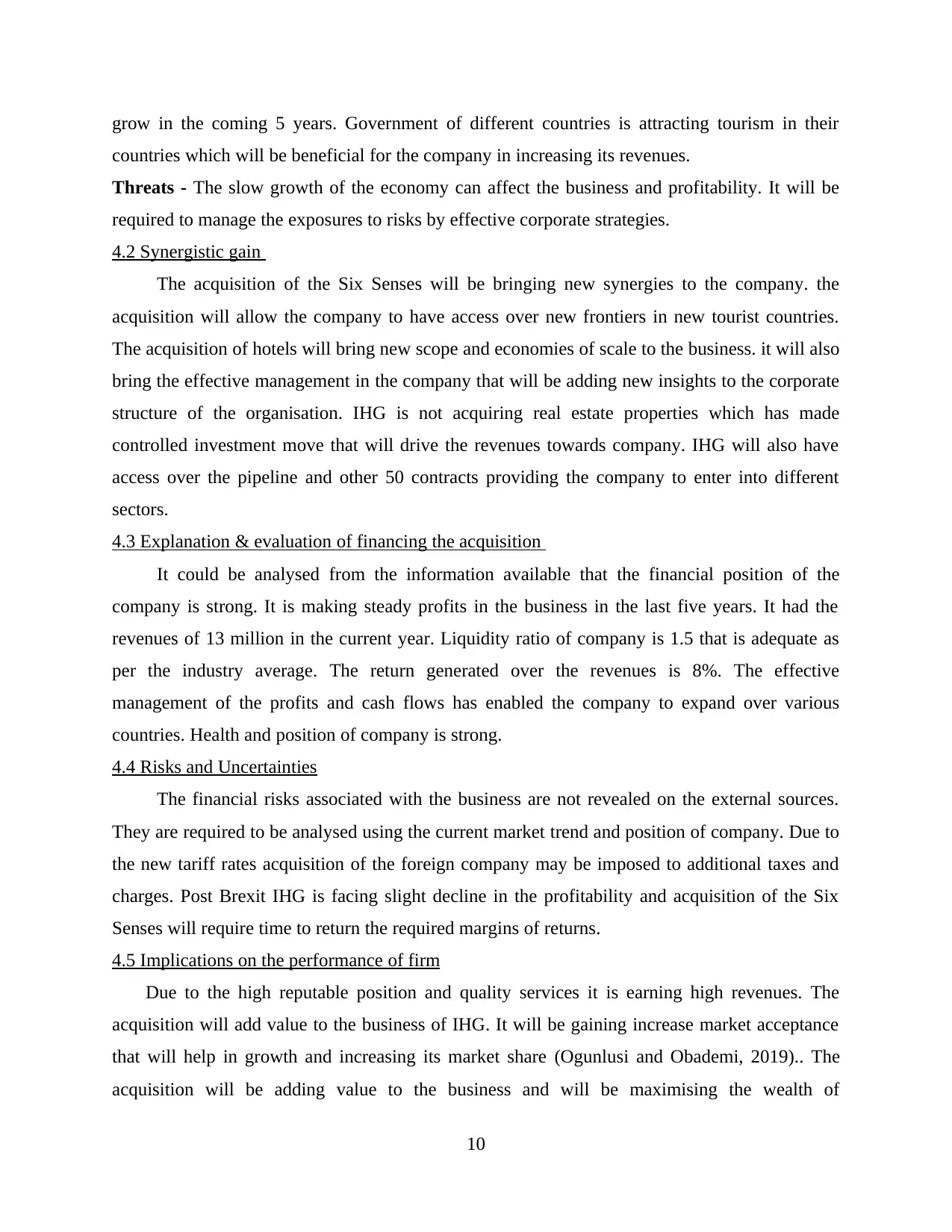
grow in the coming 5 years. Government of different countries is attracting tourism in their
countries which will be beneficial for the company in increasing its revenues.
Threats - The slow growth of the economy can affect the business and profitability. It will be
required to manage the exposures to risks by effective corporate strategies.
4.2 Synergistic gain
The acquisition of the Six Senses will be bringing new synergies to the company. the
acquisition will allow the company to have access over new frontiers in new tourist countries.
The acquisition of hotels will bring new scope and economies of scale to the business. it will also
bring the effective management in the company that will be adding new insights to the corporate
structure of the organisation. IHG is not acquiring real estate properties which has made
controlled investment move that will drive the revenues towards company. IHG will also have
access over the pipeline and other 50 contracts providing the company to enter into different
sectors.
4.3 Explanation & evaluation of financing the acquisition
It could be analysed from the information available that the financial position of the
company is strong. It is making steady profits in the business in the last five years. It had the
revenues of 13 million in the current year. Liquidity ratio of company is 1.5 that is adequate as
per the industry average. The return generated over the revenues is 8%. The effective
management of the profits and cash flows has enabled the company to expand over various
countries. Health and position of company is strong.
4.4 Risks and Uncertainties
The financial risks associated with the business are not revealed on the external sources.
They are required to be analysed using the current market trend and position of company. Due to
the new tariff rates acquisition of the foreign company may be imposed to additional taxes and
charges. Post Brexit IHG is facing slight decline in the profitability and acquisition of the Six
Senses will require time to return the required margins of returns.
4.5 Implications on the performance of firm
Due to the high reputable position and quality services it is earning high revenues. The
acquisition will add value to the business of IHG. It will be gaining increase market acceptance
that will help in growth and increasing its market share (Ogunlusi and Obademi, 2019).. The
acquisition will be adding value to the business and will be maximising the wealth of
10
countries which will be beneficial for the company in increasing its revenues.
Threats - The slow growth of the economy can affect the business and profitability. It will be
required to manage the exposures to risks by effective corporate strategies.
4.2 Synergistic gain
The acquisition of the Six Senses will be bringing new synergies to the company. the
acquisition will allow the company to have access over new frontiers in new tourist countries.
The acquisition of hotels will bring new scope and economies of scale to the business. it will also
bring the effective management in the company that will be adding new insights to the corporate
structure of the organisation. IHG is not acquiring real estate properties which has made
controlled investment move that will drive the revenues towards company. IHG will also have
access over the pipeline and other 50 contracts providing the company to enter into different
sectors.
4.3 Explanation & evaluation of financing the acquisition
It could be analysed from the information available that the financial position of the
company is strong. It is making steady profits in the business in the last five years. It had the
revenues of 13 million in the current year. Liquidity ratio of company is 1.5 that is adequate as
per the industry average. The return generated over the revenues is 8%. The effective
management of the profits and cash flows has enabled the company to expand over various
countries. Health and position of company is strong.
4.4 Risks and Uncertainties
The financial risks associated with the business are not revealed on the external sources.
They are required to be analysed using the current market trend and position of company. Due to
the new tariff rates acquisition of the foreign company may be imposed to additional taxes and
charges. Post Brexit IHG is facing slight decline in the profitability and acquisition of the Six
Senses will require time to return the required margins of returns.
4.5 Implications on the performance of firm
Due to the high reputable position and quality services it is earning high revenues. The
acquisition will add value to the business of IHG. It will be gaining increase market acceptance
that will help in growth and increasing its market share (Ogunlusi and Obademi, 2019).. The
acquisition will be adding value to the business and will be maximising the wealth of
10
⊘ This is a preview!⊘
Do you want full access?
Subscribe today to unlock all pages.

Trusted by 1+ million students worldwide
1 out of 14
Related Documents
Your All-in-One AI-Powered Toolkit for Academic Success.
+13062052269
info@desklib.com
Available 24*7 on WhatsApp / Email
![[object Object]](/_next/static/media/star-bottom.7253800d.svg)
Unlock your academic potential
Copyright © 2020–2025 A2Z Services. All Rights Reserved. Developed and managed by ZUCOL.





